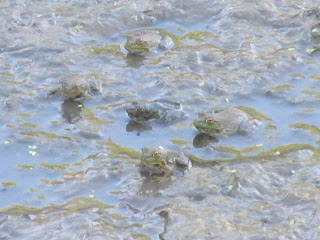Scuzzy ditch has many different niches where live thrives, but all those areas are very low in water right now. The water comes up from clear ditch, like an estuary, but also up from below in the water table. The water up the estuary has stopped, but the water table still keeps some pools open. These pools continue to support life, even as the fish in them suffocate and die.
The classic buzzard actually probably does not benefit much from these die-offs. They are traveling south for the winter months to spend time in Costa Rica, among other places. Their niche is mammals dead in thick woods. Ravens move to eating more road kill during the winter months.
Herons, small mammals and snakes feast on the small pools left in the ditch. The mud is surprisingly deep and not compacted, coming up to the knees of the kids who waded out into this fish pool. Looking closely, you can see tracks from heron, squirrel, raccoon, ducks, and of course, kids.
Herons, small mammals and snakes feast on the small pools left in the ditch. The mud is surprisingly deep and not compacted, coming up to the knees of the kids who waded out into this fish pool. Looking closely, you can see tracks from heron, squirrel, raccoon, ducks, and of course, kids.
The edges of the pools are now safe for small frogs, who dive for the deeper water at the first sign of trouble. Bullfrogs thrive in disturbed habitat, but if the edges were grassy, the leopard frogs would have the survival edge. Now the biggest bullfrog has left the pool, these guys are (almost) the top predator. Before, they were lunch for everything, now they wait for moths attracted to the reflection of the moon on the water's edge.
There is abundant water sources and the bird prey for this hawk are widely scattered. The woods in the evening are filled with the sounds of raptor calls, including owls.
There is abundant water sources and the bird prey for this hawk are widely scattered. The woods in the evening are filled with the sounds of raptor calls, including owls.
Plants are changing in the Bosque right now. The prickly pears are ripening and there are no more showy cactus flowers for the last few bees
The plants that take the most advantage of fall could be the grasses. Their seeds are ripening and being eaten by everything from birds, to people, and even ants. Most people don't realize that those lush green cultivated gardens in people's backyards are a using a specialized marsh plant, which is why they need so much watering!
The days are still hot, but the very cool nights are exposing many big insects to predations. Turkeys are gorging on grasshoppers in the. Fields each morning. The colonies of bumblebees are also expelling many members to save food during the coming winter













No comments:
Post a Comment